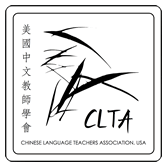From the President
December 2005
Source: CLTA Newsletter 29.3. December 2005, pp. 4-5.
Dear CLTA Members:
I would like to start by thanking Hong Gang, Cyndy, Vivian, Tianwei, Mike Everson, Margie, the Board of Directors as well as members of CLTA Journal Editorial Board for everyone’s wonderful contribution to our organization in the year of 2005. Without their selfless service to our growing field, the fundraising initiative, the email announcements, the qualitative newsletter and journal publication, the updating of the home page as well as the joint forum on K16 articulation would not be possible. I would also like to thank CLTA members who supported the organization by purchasing Tshirts at the annual meeting. In total we raised $1,480 for future fundraising activities.
On the list of the Board’s 2006 agenda, are the following items: (1) how to transfer membership registration to an online system, (2) how to prepare future CFL researchers and teachers, (3) how to obtain foundation grants to make our organization better funded, (4) how to bridge precollege and collegelevel Chinese language education. The headquarters and the board will work together to shape our future in response to the emerging “fever” of Chinese learning. However, an effective executive director and a forwardlooking board alone could not make us strong. A strong and better Chinese teaching field should be grounded in our excellence in teaching and research as well as an increasing number of students at the advancedlevel learning Chinese for different purposes. I ask all of you to step back and ask yourselves what we will do to strengthen our teaching and research skills in the next couple years. In my view, we could take action in three directions.
Joining more than one professional organization. In the past five years, the CFLfield landscape has become increasingly complex and multifaceted, shifting from a humanistic base to social science and professional Chinese language use. Our learners now include not only teenagers and young adults, but also adult learners in the governmental and business sectors. To enhance our teaching and enrich our content, we could consider joining more than one professional organization so as to draw new ideas from other related fields to innovate our teaching, such as AAS, ACTFL, MLA, and NCOLCTL*. As we engage with the different fields, we will add new dimensions to our teaching. We could also publish our research in different journals so that our research is more visible in the field of foreign language education.
Conducting collaborative research. In terms of research, we tend to think of the work of a single author, within our own discipline, and by observation of our own students. We have carried out research on beginning level CFL teaching and learning, but short of research regarding the learning at the intermediate and advanced level. We now could think about crossdisciplinary, multiinstitution, multiauthor research. We could engage with our local heritage schools, secondary schools, as well as study abroad programs in China, to conduct longitudinal study. When we work with colleagues and teachers from different sectors, we combine diverse views and strengthen each other. By conducting research together, we are able to achieve what we could not possibly achieve on our own. Professor Vivian Ling reported that the Journal received 31 manuscripts in 2004 and 23 in 2005. We hope to have more submissions in the coming years.
Thinking of longterm Chinese learning results. Regarding our students, we tend to think only about immediate results. We tend to picture students shop ping and traveling in China. Now that AP Chinese and study abroad programs extend learners’ learning experi ence and provide opportunities to practice the language with native speakers in the target culture, we need to think of how to teach our students to reach the advanced level and picture them using their advanced proficiency and accuracy in academic and professional settings. Furthermore, our learners are able to converse intelligently on the Chinese films, culture, and history with their counterparts in informal settings. We have to make up our minds that we will offer diverse courses for students with different interests and learning goals.
Chinese language education is essentially interdisciplinary, drawing on Chinese history, social science, culture, literature for building students’ humanistic prospective and on Chinese linguistics, applied linguistics and CFLspecific research as the scientific evidence supporting our pedagogy. Since we want our class content to be of depth and our methodology effective, it is necessary that we bear in mind that we must have an interdisciplinary vision.
CLTA is the place where all Chinese language teachers belong. I assure you that the officers and the board of directors possess expertise, compassion, and collaborative spirit. I joyfully ask you to join in the Board’s endeavor to build a better and stronger Chinese language teaching field for the coming generations. We will live up to the current opportunity and steadfastly march toward the mainstream of the American language teaching field.
I wish you a very happy New Year.
Sincerely,
Mienhwa Chiang
University of Pennsylvania
AAS: Association for Asian Studies
ACTFL: American Council on the Teaching of Foreign Languages
MLA: Modern Language Association
NCOLCTL: National Council of Less Commonly Taught Languages
